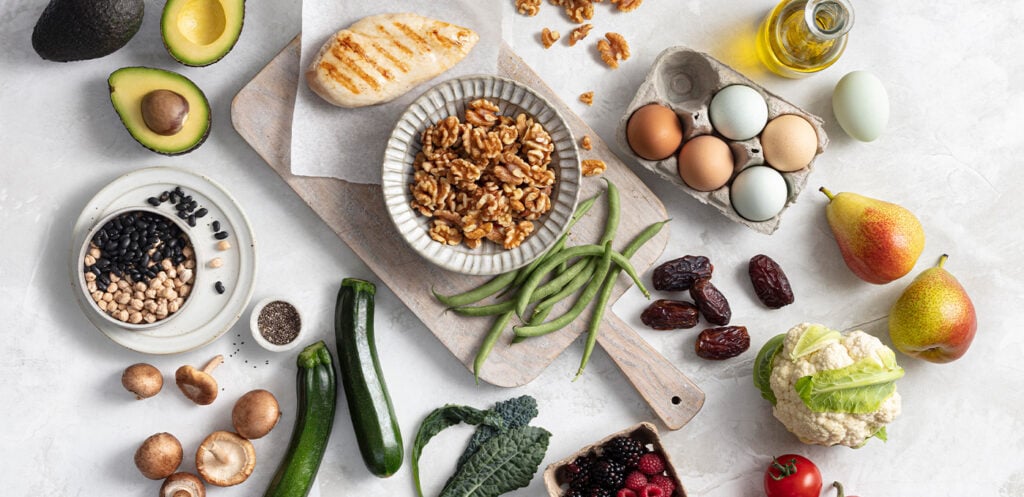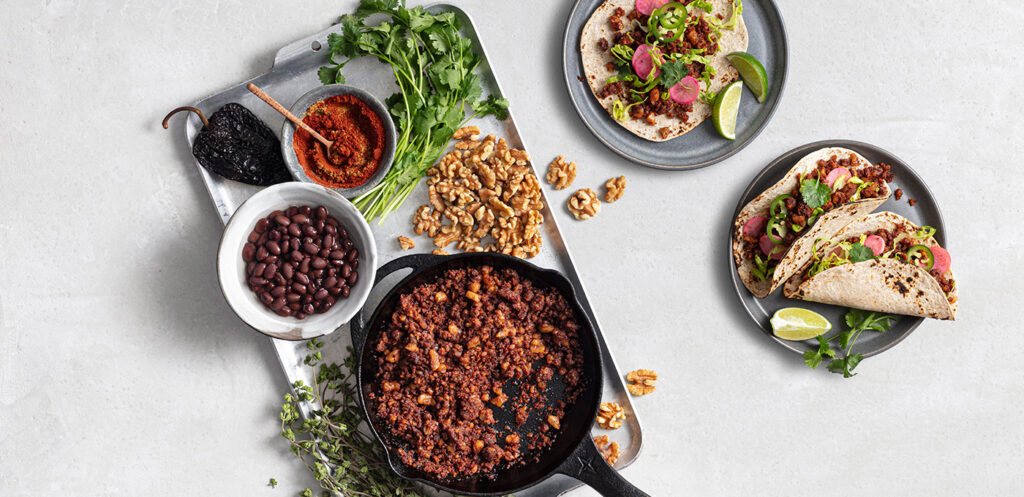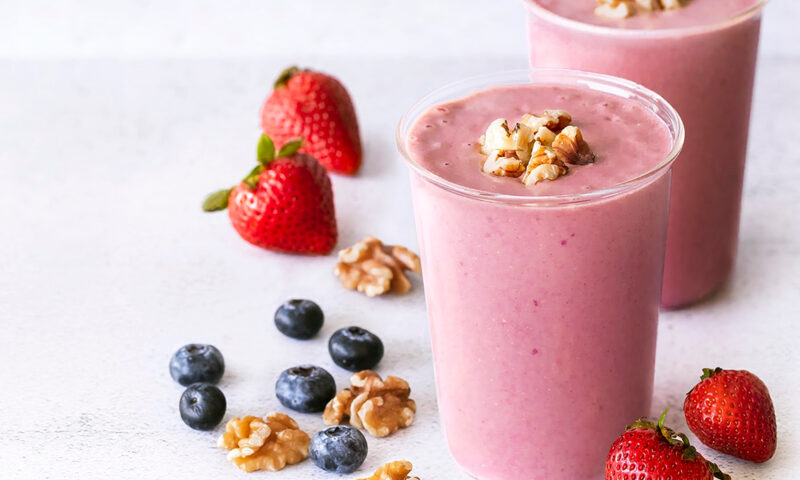
Welcome to a year of possibilities and positive changes! As we embrace 2024, let’s shift our focus from rigid resolutions to intentional habits that promote a healthier lifestyle. While food trends ebb and flow one year to the next, one notable trend in the realm of nutrition is the emphasis on putting the plant back in plant-based, a concept echoed by the annual trends data released by the food market forecast experts at Whole Foods.1
Plant-based = more plants, many ways
According to the International Food Information Council’s 2023 Food and Health Survey, 6 in 10 say they follow a plant-based or vegetarian diet to be healthier. The fact is, most want more plants on the plate, though not all the time or at every meal or snack. Though scientists typically refer to this eating pattern as a plant-based diet, others call it plant-centered, plant-powered or plant-forward. Whatever the term, the good news is that a plant-centered eating style is an inclusive dietary approach overall, and one that offers flexibility, too.
And though consumers may want more plants incorporated into their meals and snacks, they are split on their definitions of what it means to be plant-based. And that’s OK! Whether an individual consumes meat, poultry or fish some or all the time, includes dairy or eggs, or follows an exclusively vegetarian diet, the idea is to have—and the research supports—more plants on the plate, and more frequently, to support overall well-being.2,3
Still, it’s important to note that despite the interest in eating more plants, when it comes to plant protein sources particularly from nuts, seeds and soy —which naturally offer additional nutrients like fiber, phytochemicals, and other vitamins and minerals—statistics from the National Health and Nutrition Examination Survey (NHANES) reveal that less than 50% of the U.S. population are meeting the daily recommendations of these foods.4
In this article, we’ll delve into a simple yet transformative plant-based food, walnuts, and what it can contribute to your diet.
New research: Swaps and substitutions with plants
Two recently published studies show the potential impact of swapping in—even a partial substitution—plant foods for meat and the beneficial impacts on diet quality, nutrient intake, and risk factors for chronic diseases affecting Americans, including heart disease and type 2 diabetes.
Increasing nutrition and diet quality
In the first study, published in the journal Nutrients and funded by the California Walnut Commission, researchers looked at the effects of replacing some meat in the diet with walnuts and its impact on nutrient intake and diet quality.5 Using statistical analysis on a large dataset from the National Health and Nutrition Survey (NHANES) between 2015-2018, with a focus on non-nut consumers, which included 2,707 children and adolescents and 5,190 adults, scientists modeled substituting 0.5, 1.0, 1.5 and 2.0 ounces (about 7, 14, 21, or 28 walnut halves, respectively) per day to replace 1.0, 2.0, 3.0 and 4.0 ounces of meat. Important to note, no true intervention or observational analysis with the U.S. population was conducted.
However, the researchers’ analysis suggests that, across all age and gender groups, replacing just 1–1.5 ounces of meat with walnuts may improve diet quality in the U.S. population by increasing intake of certain nutrients such as dietary fiber, magnesium, and good fats, including the essential polyunsaturated fat, omega-3 ALA fatty acids. The results also showed the potential to significantly decrease the intake of dietary cholesterol. While these results have positive outcomes, this study used diet modeling and advanced statistical techniques to assess nutrient intakes. Well-designed randomized clinical trials are needed to confirm these results.
In addition, the researchers found through their analysis of the data that the partial replacement with walnuts may result in:
- Improved overall diet quality.
- Increased intake of the essential fat, omega-3 ALA
- Increased intake of fiber, magnesium and copper
- Decreased intake of cholesterol
- Decreased vitamin B12, though levels were still above the daily recommendation when walnuts replace up to 3 ounces of meat
Heart health, type 2 diabetes, and all-cause mortality
In the second published paper in BMC Medicine, researchers examined the observed effect for the substitution of any animal-based foods with plant-based foods on cardiometabolic health and all-cause mortality. The systematic review and meta-analysis of 37 studies found evidence that suggest substituting one serving per day of processed meat (approximately 50 grams or less than 2 ounces) with one serving per day of nuts (between 10 and 50 grams or 1/3 to less than 2 ounces), such as walnuts, was beneficially associated with cardiometabolic health, including a lower risk of heart disease and type 2 diabetes.6
Meta-analyses, like the above, rely on published work, presenting unique limitations, and the findings cannot be generalized to all populations and do not show cause and effect. These types of studies are informative and offer a comprehensive look at findings among patients of various backgrounds, and more research is needed to strengthen the existing evidence. Additionally, the included studies were observational and unknown confounding factors could not be ruled out. Due to the observational design of the included studies, they can often include an element of selection bias.
Walnuts are a Nutritious, Tasty and Versatile Ingredient
Whether on their own or as a substitution for meat in the diet, walnuts provide many benefits when added to meals and snacks. In the pursuit of putting more plants back into eating, walnuts can be a versatile and practical option as a partial replacement for meat while adding nutrition, as well as a pleasing texture and flavor.
Not only do walnuts provide a host of important nutrients and phytochemicals, they also provide a notable amount of plant protein at 4 grams per ounce (12-14 halves), contribute to the daily intake of fiber (4 grams) and are a good source for magnesium (45 milligrams). Additionally, they are the only nut that is an excellent source of the plant omega-3 ALA (2.5g/oz), (essential fat alpha linolenic acid).7
But what I love about them equally is their personality. Walnuts pair well with both sweet and savory foods and flavors and can fit within the wide array of culinary traditions from around the globe. I like to say that they play well with others – other ingredients from the plant kingdom, as well as marine, poultry, dairy, and meat. In fact, because of their texture, they can take on varied qualities in recipes ranging from whole and crunchy, to the consistency of ground meat, all the way to smooth, depending on kitchen techniques and their intended uses.
Making it Easier to Enjoy A Plant-Centered Lifestyle With or Without Meat

The key to finding ways to swap or substitute delicious, versatile options to optimize an eating pattern where plants are at the center is to look for foods that you know and like already that also plus-up your nutrition. One easy way to include more plant-based foods in the diet is using walnuts as a partial replacement for meat in a meal or snack. Because of their ability to take on the texture and consistency of ground meat and compliment various flavor profiles, they can be seamlessly integrated into a variety of recipes.
An additional perk: You can make your plant-based walnut meat in advance and use it across several meals during the week. And just like fresh walnuts which are best stored in airtight containers or snack bags to ensure they’re fresh and ready to consume, store your walnut meat sealed well in the fridge for up to four days or in the freezer for longer periods.
Here are a few delicious ways to make some fun and flavorful swaps and substitutions for meat with walnuts:

- Whether you are adopting the Meatless Monday tradition or love your Taco Tuesdays, you can swap in a walnut chorizo for ground beef or ground turkey. It’s so easy to make, full of flavor, and makes a delicious addition to your tacos or grain bowls.
- Meatless Meatballs? Yes! The comfort of meatballs can be made for your favorite pasta dish with a meatless – or partial substitution – recipe using walnuts and topped with your favorite homemade or storebought marinara. Here’s one easy Italian-inspired recipe with roasted peppers, garlic and parsley. And another favorite: Greek-style meatballs with feta, capers, and dried herbs served with tzatziki sauce.
- Meatloaf is another comfort food for many, and an easy family go-to meal. If you have your own favorite recipe and seasonings, you could try substituting 1/4 to 1/3 of the meat for chopped walnut ‘crumble’ and you’ll boost nutrients like omega-3 ALA and fiber and instantly add more plants to your plate. And here’s another great all-plant meatloaf recipe made with walnuts, cannellini beans, and seasonings, and incorporates quinoa and chia seeds that help bind it together and keep it moist while adding even more nutrition.
- Make ahead meals with sweet potatoes and walnuts. Make a batch of sweet potato walnut falafel ahead of time, and then serve them up in a grain bowl with other vegetables, in a pita at lunchtime, as a main or side dish at dinner alongside roasted vegetables, or with toothpicks and a dipping sauce for appetizers or as a snack.
As you embark on this journey of incorporating walnuts into your diet, remember that small changes can lead to significant improvements in your well-being. You can access more than 30 years of research on walnuts here. And be sure to explore the delicious and diverse recipes on Walnuts.org as you educate others and experience the walnut effect as it enhances your meals and overall well-being. Cheers to a healthier and more wal-nutritious year ahead!
Wendy Bazilian, DrPH, MA, RDN (wendybazilian.com) is an educator, food enthusiast and award-winning journalist. She has a doctoral degree in public health and nutrition from Loma Linda University in Loma Linda, CA—one of the Blue Zones—is a registered dietitian and ACSM-certified Exercise Physiologist. Wendy is author and contributor to several best-selling and award-nominated books and maintains an active private practice and consulting business in San Diego where she lives, surfs, cooks, and plays with her daughter (and husband). Wendy is an expert communications and strategy consultant to the spa industry, to start-up and established food and commodity groups, and to the healthcare industry. A frequent nutrition and wellness keynote presenter at scientific, medical, corporate, food industry, culinary and public conferences and festivals and a is a frequent contributor and guest on national and local media. @bazilians



